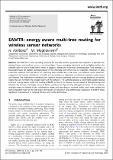EAMTR: Energy aware multi-tree routing for wireless sensor networks
Author(s)
Fariborzi, Hossein; Moghavvemi, M.
DownloadFariborzi-2009-EAMTR Energy aware multi-tree routing for wireless sensor networks.pdf (337.8Kb)
PUBLISHER_POLICY
Publisher Policy
Article is made available in accordance with the publisher's policy and may be subject to US copyright law. Please refer to the publisher's site for terms of use.
Terms of use
Metadata
Show full item recordAbstract
IEEE 802.15.4 is the prevailing standard for low-rate wireless personal area networks. It specifies the physical layer and medium access control sub-layer. Some emerging standards such as ZigBee define the network layer on top of these lower levels to support routing and multi-hop communication. Tree routing is a favourable basis for ZigBee routing because of its simplicity and limited use of resources. However, in data collection systems that are based on spanning trees rooted at a sink node, non-optimal route selection, congestion and uneven distribution of traffic in tree routing can adversely contribute to network performance and lifetime. The imbalance in workload can result in hotspot problems and early energy depletion of specific nodes that are normally the crucial routers of the network. The authors propose a novel light-weight routing protocol, energy aware multi-tree routing (EAMTR) protocol, to balance the workload of data gathering and alleviate the hotspot and single points of failure problems for high-density sink-type networks. In this scheme, multiple trees are formed in the initialisation phase and according to network traffic, each node selects the least congested route to the root node. The results of simulation and performance evaluation of EAMTR show significant improvement in network lifetime and traffic distribution.
Date issued
2009-05Department
Massachusetts Institute of Technology. Department of Electrical Engineering and Computer ScienceJournal
IET Communications
Publisher
Institute of Electrical and Electronics Engineers
Citation
Fariborzi, H., and M. Moghavvemi. “EAMTR: energy aware multi-tree routing for wireless sensor networks.” Communications, IET 3.5 (2009): 733-739. ©2009 The Institution of Engineering and Technology.
Version: Final published version
Other identifiers
INSPEC Accession Number: 10626728
ISSN
1751-8628